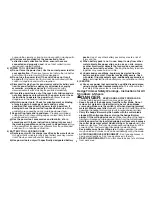
8
more effectively.
• Start by trimming the top of the hedge.
Hold the tool at the desired angle and move it
steadily along the line of cut. The double-sided
blade allows you to cut in either direction.
• In order to obtain a very straight cut, stretch a
piece of string along the length of the hedge at
the desired height. Use the string as a guide
line, cutting just above it.
• In order to obtain flat sides, cut upwards with
the growth (
fig. I). Younger stems move
outwards when the blade cuts downwards,
causing shallow patches in the hedge.
• Take care to avoid any foreign objects. Especially avoid hard objects
such as metal wire and railings, as these could damage the blades.
• Regularly oil the blades.
Maintenance
Your Black+Decker tool has been designed to operate over a long
period of time with a minimum of maintenance. continuous satisfactory
operation depends upon proper tool care and regular cleaning.
Your charger does not require any maintenance apart from regular cleaning.
WARNING
:
Before performing any maintenance on the
tool, switch off the tool. Unplug the charger before cleaning it.
• Regularly clean the ventilation slots in your tool and charger using a soft
brush or dry cloth.
• Regularly clean the motor housing using a damp cloth. Do not use any
abrasive or solvent-based cleaner.
• After use, carefully clean the blades. After cleaning, apply a film of light
machine oil to prevent the blades from rusting.
Storage
When the tool will not be used for several months, ideally leave the
battery connected to the charger. Otherwise proceed as follows:
• Fully charge the battery.
• Store the tool in a secure and dry location. The storage temperature
must always remain in the range of 41°F (5°c) to 104°F (40°c).
• Before using the tool after prolonged storage, fully charge the battery again.
Accessories
• recommended accessories for use with your tool are available
from your local dealer or authorized service center. If you need
assistance regarding accessories, please call:
1-800-544-6986.
WARNING
:
The use of any accessory not
recommended for use with this tool could be hazardous.
The RBRc™ Seal
The RBRC™ (Rechargeable Battery Recycling Corporation) Seal on the nickel-
cadmium or lithium-ion battery (or battery pack) indicates that the costs to
recycle the battery (or battery pack) at the end of its useful life have already
been paid by BLACK+DECKER. In some areas, it is illegal to place spent nickel-cadmium
or lithium-ion batteries in the trash or municipal solid waste stream and the RBRC
program provides an environmentally conscious alternative. RBRC in cooperation with
BLACK+DECKER and other battery users, has established programs in the United States
and Canada to facilitate the collection of spent nickel-cadmium or lithium-ion batteries.
Help protect our environment and conserve natural resources by returning the spent
batteries to an authorized BLACK+DECKER service center or to your local retailer for
recycling. You may also contact your local recycling center for information on where
to drop off the spent battery, or call 1-800-8-BATTERY. NOTE: Batteries are integrated
into the tool and should not be removed. To recycle, return the tool to an authorized
BLACK+DECKER service center.
Service Information
All BLACK+DECKER Service Centers are staffed with trained personnel to provide
customers with efficient and reliable power tool service. Whether you need technical
advice, repair, or genuine factory replacement parts, contact the BLACK+DECKER
location nearest you. To find your local service location, call: 1-800-544-6986 or visit
www.blackanddecker.com
This Class B digital apparatus complies with Canadian ICES-003. This device
complies with part 15 of the FCC rules. Operation is subject to the following two
conditions: (1) This device may not cause harmful interference, and (2) this device
must accept any interference received, including interference that may cause
undesired operation. NOTE: This equipment has been tested and found to comply
with the limits for a Class B digital device, pursuant to Part 15 of the FCC Rules. These
limits are designed to provide reasonable protection against harmful interference
in a residential installation. This equipment generates, uses and can radiate radio
frequency energy and, if not installed and used in accordance with the instructions,
may cause harmful interference to radio communications. However, there is no
guarantee that interference will not occur in a particular installation. If this equipment
does cause harmful interference to radio or television reception, which can be
determined by turning the equipment off and on, the user is encouraged to try to
correct the interference by one or more of the following measures:
I









































